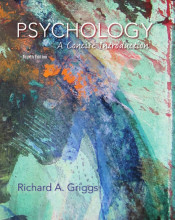Current paradigms in psychopathology
83 important questions on Current paradigms in psychopathology
How do we call a conceptual framework or approach in which a scientist works; a set of basic assumptions, or a general perspective that defines how to conceptualize and study a subject?
What are the three paradigms that guide the study of psychopathology and treatment?
- genetic
- neuroscience
- cognitive behavioral
How do we call the carriers of genetic information?
- Higher grades + faster learning
- Never study anything twice
- 100% sure, 100% understanding
How do we call a group of genes controlling a specific character trait of an individual?
How do we call the principle that refers to the extend to which variability in a particular trait in a population can be ascribed to genetic factors?
What are the characteristics of heritability?
- estimated in a range from 0.0 to 1.0
- is only relevant for a large population, there is no heritability in an individual
How do we call environment characteristics that members of a family have in common, like family income, and parental marital status?
How do we call environment characteristics that are distinct among members of a family, like friendships relations, or specific events unique to a person?
What are the two broad approaches within the genetic paradigm?
- behavior genetics
- molecular genetics
How do we call the study of the degree to which genes and environmental factors influence behavior?
How do we call the total genetic makeup of an individual?
How do we call the totality of observable behavior and other characteristics?
How do we call studies that seek to identify particular genes and their functions?
How do we call the principle that refers to a difference in DNA sequence on a gene that has occurred in a population?
Describe the steps of protein synthesis.
- transcription; transcribing the blueprint for the protein from the DNA gene into a messenger RNA.
- mRNA takes the genetic information from the nucleus to the ribosomes, where the proteins are made.
- translation; transfer RNA reads the genetic code and delivers the needed amino acids to the ribosome to form a polypeptide chain
- a protein is created
How do we call the fact that a given person's sensitivity to an environmental event is influenced by genes?
How do we call the study of how environment can alter gene expression or function?
What are the two challenges scientists working with the genetic paradigm face?
- specify exactly how genes and environments reciprocally influence each other
- recognizing the complexity of the task, knowing that several genes will contribute to a specific disorder
How do we call the view that holds that psychological disorders are linked to aberrant processes in the brain?
What are the four major parts of a neuron?
- the cell body
- several dendrites
- one or more axons of varying lengths
- terminal buttons on the end branches of axons
How do we call the gap between the terminal endings of the sending axon and the cell membrane of the receiving neuron?
How do we call chemicals that allow neurons to send a signal across the synapse to another neuron?
How does sending a signal from one neuron to another work?
- neurotransmitters are flowing into the synapse to the other neuron
- some of the neurotransmitters reach the postsynaptic neuron
- the cel membrane of the postsynaptic neuron contains receptors, which are specific so only certain neurotransmitters can fit into specific receptors.
- when a neurotransmitter fits into a receptor site, a message can be sent to the postsynaptic cell.
- sometimes messages are excitatory, sometimes inhibitory
What happens to neurotransmitters that don't reach the postsynaptic neuron?
- reuptake; some neurotransmitters are taken back into the presynaptic cell.
- what remains in the synapse is broken down by enzymes.
What neurotransmitter inhibits nerve impulses throughout most areas of the brain, involved in anxiety disorders.
How do we call a drug that stimulates a particular neurotransmitter's receptors, because it produces the same effect as the neurotransmitter?
How do we call a drug that works on a neurotransmitter's receptor to dampen or block the effect or activity of that neurotransmitter?
How do we call the major connection between the two hemispheres consisting of a band of fibers?
Which lobe is located at the rear end of the brain?
Which lobe is located at the middle at the sides of the brain?
Which function is associated with the occipital lobe?
Which function is associated with the temporal lobe?
Which function is associated with the frontal lobe?
- reasoning
- problem solving
- working memory
- executive functions
- emotion regulation
How do we call the tissue that holds the myelinated fibers that connect the cell bodies?
Where can we find grey matter mostly and where can we find white matter mostly?
How do we call brain areas that are centers in the lower brain where sets of nerves converge and messages are integrated from different centers and areas in the brain?
How do we call a set of areas collectively located deep in the hemispheres that help regulate starting and stopping motor and cognitive activity?
How do we call a set of nuclei that functions as a relay station for all sensory pathways, receiving nearly all impulses arriving from different sensory areas in the body before passing them on to the cortex where they are interpreted as sensations?
Of which two components does the brain stem consist?
- the pons
- the medulla oblongata
What are the functions of the pons and medulla oblongata?
- pons; contains tracts that connect the cerebellum with the spinal cord and with the motor areas of the cerebrum
- medulla oblongata; serves as the main line of traffic for tracts ascending from the spinal cords, and descending from the higher centers of the brain.
Which brain area receives information that integrates to balance, posture, equilibrium and smooth coordination of the body in motion?
Which subcortical brain areas are associated with memory?
- anterior cingulate
- septal area
- hippocampus
With what functions is the hypothalamus associated?
- regulation of the metabolism
- regulation of the temperature
- regulation perspiration (transpiratie)
- regulation blood pressure
- regulation sleeping
- regulation appetite
How do we call the elimination of synaptic connections during adolescence?
What concept is central to the body's response to stress?
How does the HPA axis work?
- when people are faced with threat, the hypothalamus releases corticotropin-releasing factor CRF.
- CRF communicates with the pituitary gland.
- the pituitary gland releases adrenocorticotopic hormone which travels to the adrenal glands
- the adrenal cortex promotes release of cortisol. often referred to as the stress hormone.
How do we call the concept that operates automatic an controls the endocrine glands, and muscles around the blood vessels, stomach, intestines, kidneys, and other organs?
How do we call the field that studies how psychological factors impact the immune system?
What are the characteristics of the natural immunity system?
- first and quickest line of defense against infectious microorganisms
- different cells like macrophages and natural killer cells are released and destroy the invader
- macrophages release cytokines which help initiate bodily responses to infections
What are the characteristics of the specific immunity?
- react more slowly to infection
- different cells involved to identify specific infection that needs specific antibodies to destroy infectional microorganisms
How do we call the view that whatever is being studies can and should be reduced to its most basic elements or constituents?
Problem behavior is most likely to continue if reinforced, by which possible consequences could problem behavior be reinforced?
- escaping from tasks
- getting attention
- generating sensory feedback
- gaining access to desirable things or situations
A problem with reinforcing desired behavior is that it can't continuously be reinforced forever. how is this problem overcome?
intermittent reinforcement makes desired behavior more enduring
How do we call an example of operant conditioning which involves helping a person engage in tasks that provide an opportunity for positive reinforcement?
How do we call a form of behavioral activation therapy that involves deep muscle relaxation and gradual exposure to a list of feared situations starting from minimal anxiety to the most frightening?
Which kinds of exposure are there?
- in vivo; real life exposure
- imaginal exposure; addresses fears such as rape, trauma etc. which can't be exposed to in real life.
How do we call the treatment that alters behavior, feelings, and symptoms by changing a pattern of thought?
What is a general term for changing a pattern of thought?
Describe Beck's cognitive behavior therapy.
- developed a cognitive behavioral therapy for people suffering from depression
- theory; depressed mood is caused by distortions in the way people perceive life experiences
- a person with depression may focus exclusively on negative happenings, and ignore positive ones.
- goal of the therapist is to point out the overlooked things, or holes in a client's tunnel vision in order to alter cognition.
Emotions are believed to have a number of components, among others which components are included?
- expressive
- experiential
- physiological
Which component of emotion refers to how someone reports he feels at a given time, or in response to some event?
Which component of emotion refers how someone's facial expression indicate emotions?
Which component of emotion refers to changes in the body that are accompanied by emotion?
What are two important considerations in the study of emotion and psychopathology?
- consider which of the emotional components is affected by the disorder
- consider the ideal affect of the patient
How do we call the kinds of emotional states that a person ideally wants to feel?
How do we call a person's responses to an analyst that seem to reflect attitudes and ways of behaving toward important people in the past, rather than reflecting actual aspects of the relationship between the person and the analyst?
Theories built on the concept of transference stress the importance of a person's interpersonal relationships for psychological well being, what are those theories?
attachment theory
What theory stresses the importance of long-standing patterns in close relationships, particularly within the family, that are shaped by the ways people think and feel?
What is the thought of the attachment theory?
How do we call a treatment that emphasizes the importance of current relationships in a person's life, and how problems in these relationships can contribute to psychological symptoms?
How does interpersonal therapy (ITP) work?
- the therapist encourages the patient to identify feelings about his relationships and express these feelings.
- the therapist then helps the patient generate solutions to interpersonal problems.
In interpersonal therapy (ITP), four interpersonal issues are assessed to examine wether one or more of them might be impacting symptoms, what are these issues?
- unresolved grief
- role transitions; going from child to parent, or from worker to retired
- role disputes; resolving different relationship expectations for example
- interpersonal or social deficits; experienced difficulties in social life.
How do we call an integrative paradigm that links genetic, neurobiological, and environmental factors?
Name some examples of heritable predispositions
- genotype
- temperament
Name some examples of early experiences
- nurture
- trauma
- deprivation
Name some examples of strength and vulnerability
- fenotype
- schemas; cognition; attribution
- neuro-endocrine
- personality
- etc.
Name some examples of support and stress
- social support
- medication
- psychotherapy
- daily stress
- trauma
- life events
Describe the diathesis-stress paradigm
- heritable predispositions and early experiences influence each other (nature through nurture)
- together, heritable predispositions and early experiences influence strengths and vulnerabilities.
- strength and vulnerabilities and support and stress influence each other
- together, strength and vulnerabilities and support and stress determine the presence, and if present, the severity of complaints and symptoms.
- complaints and symptoms influence support and stress, and also influence strength and vulnerability.
Besides the diathesis-stress paradigm, there is another integrative paradigm, how is this called?
What are the levels of the levels of description, explanations, and research?
- complaints and symptoms; clinical practice and clinical trials
- processes; experimental clinical research
- physiology; fundamental research, and psychoactive drugs
Which factors influence the success rate of a research?
- expectancy and placebo effect
- therapeutic relationship
- technique and model factors
- client variables and extra therapeutic events
Which neurotransmitter communicates with the sympathetic nervous system where it is involved in producing states of high arousal, thus may be involved in anxiety disorders and other stresst related conditions?
What are the key neurotransmitters implicated in psychopathology?
- dopamine
- serotonin
- norepinephrine
- gama-aminobutyric acid, GABA
The question on the page originate from the summary of the following study material:
- A unique study and practice tool
- Never study anything twice again
- Get the grades you hope for
- 100% sure, 100% understanding
































